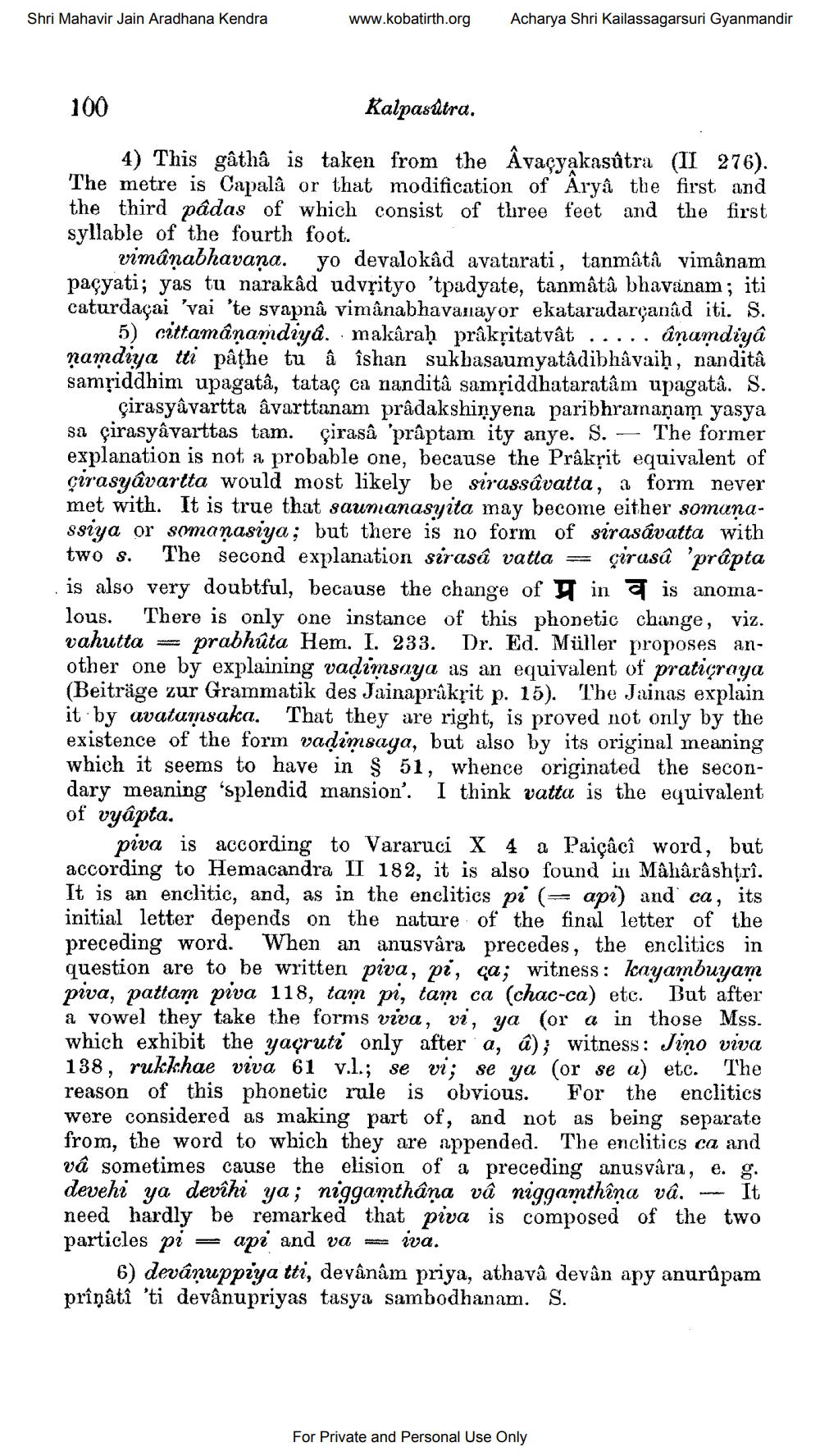________________
Shri Mahavir Jain Aradhana Kendra
www.kobatirth.org
Acharya Shri Kailassagarsuri Gyanmandir
100
Kalpasútra.
4) This gâthâ is taken from the Âvaçyakasûtra (II 276). The metre is Capalâ or that modification of Aryâ the first and the third pâdas of which consist of three feet and the first syllable of the fourth foot.
vimânabhavaņa. yo devalokâd avatarati, tanmatâ vimânam paçyati; yas tu narakâd udvrityo 'tpadyate, tanmatâ bhavanam; iti caturdaçai 'vai 'te svapnâ vimânabhavanayor ekataradarçanâd iti. S.
5) cittamânamdiya. makâraḥ prâkritatvât ..... âņamdiyâ namdiya tti pâțhe tu â îshan sukbasaumyatâdibhậvaiḥ, nanditâ samriddhim upagata, tataç ca nanditâ samriddhataratâm upagatâ. S.
çirasyâvartta âvarttanam prâdakshinyena paribhramanam yasya sa çirasyâvarttas tam. çirasâ 'prâptam ity anye. S. – The former explanation is not a probable one, because the Prâkrit equivalent of çirasyâvartta would most likely be sirassavatta, a form never met with. It is true that saumanasyita may become either somanassiya or somaṇasiya; but there is no form of sirasavatta with two s. The second explanation sirasâ vatla = virusâ 'prâpta is also very doubtful, because the change of u in af is anomalous. There is only one instance of this phonetic change, viz. vahutta = prabhậta Kem. I. 233. Dr. Ed. Müller proposes another one by explaining vadimsaya as an equivalent of pratiçraya (Beiträge zur Grammatik des Jainaprâkrit p. 15). The Jainas explain it by avatamsaka. That they are right, is proved not only by the existence of the form vadimsaga, but also by its original meaning which it seems to have in $ 51, whence originated the secondary meaning 'splendid mansion'. I think vattu is the equivalent of vyâpta.
piva is according to Vararuci X 4 a Paiçâcî word, but according to Hemacandra II 182, it is also found in Mâhârâshțrî. It is an enclitic, and, as in the enclitics pi (= api) and ca, its initial letter depends on the nature of the final letter of the preceding word. When an anusvåra precedes, the enclitics in question are to be written piva, pi, ça; witness: kayambuyam piva, pattam piva 118, tam pi, tam ca (chac-ca) etc. But after à vowel they take the forms viva, vi, ya (or a in those Mss. which exhibit the yacruti only after a, a); witness: Jiño viva 138, rukkhae viva 61 v.l.; se vi; se ya (or se a) etc. The reason of this phonetic rule is obvious. For the enclitics were considered as making part of, and not as being separate from, the word to which they are appended. The enclitics ca and vâ sometimes cause the elision of a preceding anusvåra, e. g. devehi ya devîhi ya; niggamthâņa vâ niggamthâņa vâ. --- It need hardly be remarked that piva is composed of the two particles pi – api and va — iva.
6) devánuppiya tti, devânâm priya, athavâ devân apy anurûpam prîñâtî 'ti devânupriyas tasya sambodhanam. S.
For Private and Personal Use Only




